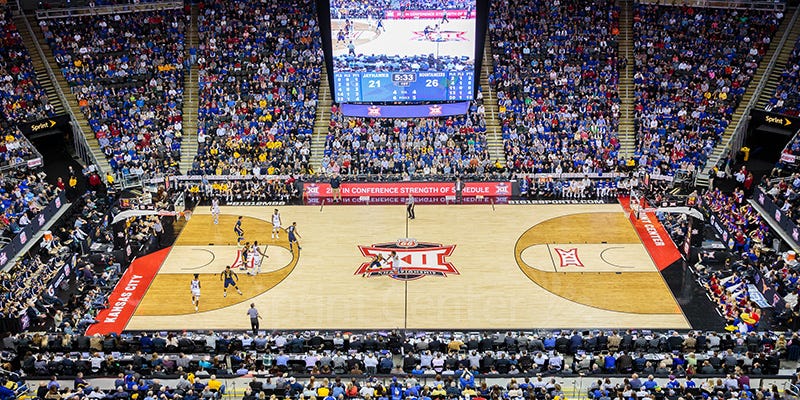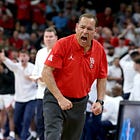Better Know a Conference: Big 12 (Part I)
Featuring: Iowa State coach T.J. Otzelberger on how (and why) he turned the Cyclones into a defensive monster
Better Know a Conference is Buzzer’s league-by-league preview of the 2024-25 season, featuring Bubble Watch-length narrative looks at every team in every major league — and other conferences and mid-majors along the way — in rough order of expected finish.
To read the full series (and start posting on the best college hoops comment section on the Internet!) consider becoming a paid subscriber today. Today: The Big 12, Part I.
These conferences are too damn big.
Time was, if the editorial priorities of your employer allowed for it, you could write a really in-depth preview of a conference, overfull with tangents and narratives and even some actual basketball analysis, and you could manage to get every team in a league in one unified piece. But noooo, not anymore. Not now. Now every league (except the Big East; love you Big East; never change, Big East) has to have between 16 and 18 teams, and the idea of spending any sort of meaningful depth on each team in these messy leagues requires you to either a) don’t, or b) divvy things up.
(Are we too wordy? Should we spam emails to people with one team preview every day all offseason to try to convert more subscribers? No, it’s the conferences who are wrong.)
That’s sort of how we feel about the new Big 12, at the end of the day: It’s messy. On the one hand, a powerhouse like Arizona joining a buzzsaw league to play against Kansas and Baylor and Houston, the latter of which just added to the brutal party a year ago, is kind of undeniably awesome. On the other hand, the primary appeals of the 2013-2023 Big 12 were:
Its symmetry (10 teams, simple 18-game round robin regular season schedule) and
Its sheer pound-for-pound strength.
Both of those qualities are now lost. This is still an incredibly good league with elite programs and national title contenders and more than its fair share of postseason hopefuls. But no matter how good these teams are in any given season, the additions of Cincinnati, UCF and BYU, and now Arizona State, Colorado and Utah, have muddied some previously pristine waters. Beyond the relative geographic and cultural cohesion, in the past decade the Big 12 often pushed eight or nine of its 10 teams close to bids — since 2014 it has ranked No. 1 in KenPom.com’s conference efficiency rankings all but twice, and both times it was a tight No. 2 — and the regular season was constantly enthralling as a result. It is hard to imagine the new, more diffuse Big 12 matching that level of nightly knife-fight fervor. Sort of a bummer.
Good news: It is still going to be a very fun and very good league, maybe the best in the country yet again. It was still No. 1 a year ago, after all — and Big 12 commissioner Brett Yormark has made it clear that he sees college hoops as an undervalued component of the TV media rights landscape, which is a promising statement of long-term priorities.
It also features at least three national title contenders, starting with … ah, well, let’s just dig in, actually:
Houston
Say what you want about realignment — we certainly have — but sometimes it does make sense. Rarely has a recently realigned program so perfectly vibed with the league it just joined. The 2023-24 Houston Cougars didn’t just fit the Big 12 stylistically — though their brutally aggressive no-middle defense and emphasis on raw physical strength (sometimes at the expense of, or to make up for a lack of, technical offensive skill) definitely did that — they arrived as the ur-practitioners of that style, the best in class. It wasn’t all that long ago that Houston got some of the same rhetorical treatment as Gonzaga in league play. The AAC? Throw them in a real league and see what happens! Dumb. Realignment dumped Houston into the best league in the country; in year one the Cougars won it with a game to spare.
There is zero reason to expect anything different this year. Indeed, Houston could have far less of last year’s already experienced team back, and you would implicitly trust Kelvin Sampson to compete for the conference title, such is his program’s annual, almost automated excellence. But these Cougars do have a ton back. They should enter the season as one of the favorites — maybe even the clear top choice — to win the national title.
Indeed, there is almost no need to dive super deep on Houston, at least in a tactical sense. The copious strengths remain, as do the few questions.
Houston will be the toughest team in the country, or one of them. Houston will guard like crazy. Houston will foul a lot defensively, the trade-off for extending outward a defense that blocks a ton of shots, forces a ton of steals, kills almost every kind of opposing offensive action and contests every resulting shot with borderline religious ardor. Bigs J’Wan Roberts and Ja’Vier Francis (and rising sophomore Joseph Tugler, and redshirt freshman Jacob McFarland, and even wing Terrance Arceneaux, assuming he returns healthy from last season’s Achilles tear) will rebound a ton of Houston’s misses on the offensive end and turn those misses into layups and open kickout 3s. Houston will always take more shots, and almost always more good shots, than its opponent. Houston will thus churn out consistently efficient offensive performances, even if it doesn’t always look particularly pretty in doing so. These structures remain in place. Same as it ever was.
The big concern about last year’s Houston team — the one you could see as early as a narrow Dec. 1 win at Xavier, when the Cougars’ offense first noticeably stalled out — likewise carries over this year. Put simply: Is this group purely talented enough to win a national title? When Marcus Sasser and Jarace Walker were still on campus two years ago, when they peppered NBA-type scoring skill atop Houston’s indefatigable broader system, the answer was undeniably yes. A year ago, though? Jamal Shead did his best, and had an incredible senior season, but Shead was nonetheless a converted role player doing his closest impression of a star — and in any case when he was injured late in the year a tourney exit to a team like Duke, stocked with five-stars and future NBA players, felt almost inevitable.
To avoid the same fate this season — a No. 1 seed that doesn’t quite have the horses to go toe-to-toe with any of a few really locked in and supertalented teams come March — LJ Cryer will have to be the next Cougars backcourt star. He is already mostly there. Cryer posted a 120.8 offensive rating while taking 27.4 of Houston’s shots a season ago, and made 38.8 percent of his 3s. But he was often playing off the ball, and he will likely need to do a lot more on it this year, and without Shead’s ability to beat the first man, get into the top of the paint, and collapse a defense around him. Of course, this is Houston, which just accomplished the exact same offseason ask with Shead; why wouldn’t Cryer morph into a lead guard in roughly the same way?
The other candidate for offensive improvement comes via Oklahoma, where Milos Uzan was regarded as a potential breakout sophomore before flopping. Uzan shot 40.1 percent from 3 as a freshman, but fell to 29.6 percent with more attempts as a sophomore, and while his assist and turnover rates went in the right direction from a very sloppy freshman season, the latter was still too high (19.5 percent) to consider him a particularly reliable ballhandler.
Then again: Uzan has clear talent at his size, and anyway this is Houston, not Oklahoma. The former’s players tend to improve massively, and rapidly, when they get to the Fertitta Center, and Sampson wouldn’t have taken on a very familiar Big 12 opponent if the coach didn’t see something he could transform.
That is, as ever, the safest assumption about this program: Guys will get better. Year after year, Sampson has absorbed significant personnel losses. Year after year, his teams have kept improving anyway. There is only one more place left for this process, for Sampson’s machine, to take him.
The question is not whether Houston is capable of getting there. When you’re one of the two or three most effective teams in the country for five months, of course you could get to the Final Four. The question is whether the thrillingly uncontrollable details of the NCAA Tournament — a bad shooting night, injuries, an unfavorable matchup that requires some individual offensive brilliance, whatever — are the impediment again.
The margins get tight in March. The best team doesn’t always win. That is all there is left to stop Sampson now: the fates.
Iowa State
Keep reading with a 7-day free trial
Subscribe to Buzzer by Eamonn Brennan to keep reading this post and get 7 days of free access to the full post archives.




